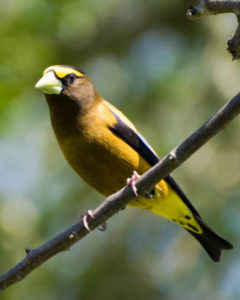
The evening grosbeak is one boreal species that has seen dramatic population declines. Photo by G Gentry and courtesy of USFWS
When we think of boreal forests, we may think of dense networks of coniferous trees covering the landscape, but the reality is a bit more complicated than that- in addition to deciduous trees in the understory and canopy and bodies of water of all shapes and sizes, boreal forests are mosaics with patches of different ages, structures, and species compositions (Hansson 1992). Wildfires, storms, insect outbreaks and a number of other disturbances constantly change the look of the forest killing plants, opening up areas for new colonization, and creating complex habitat for wildlife. So if trees are constantly dying and vegetation patches continually disappear from the forest, the animals that live there should be pretty well set to deal with many kinds of change, right? The disturbances caused by people fit well within their tolerances? The answer to that question is slightly yes, but largely no- when humans come into the forest, things start to change in new ways, some of which boreal birds can adjust to, but others of which create real problems for these species. Why is this important? Well, birds represent more than 75% of all vertebrate species in boreal forests (Monkkonen and Viro 1997) and in eastern Canada alone more than 70 songbird species are commonly found nesting in boreal habitat (Erskine 1977).
For the most part, logging does not mimic the natural processes that keep boreal forests in flux. Sometimes forest management involves removing everything from blocks of forest- but clear-cutting creates sharp edges between open and forested land, whereas storm damage and insects rarely work in well-defined polygons. And while wildfires and logging both remove understory and kill trees, logging tends to be much more selective in what is removed and what stays. Wildfires leave some dead trees from a variety of species standing, but logging practices may remove all dead snags, depriving cavity nesting birds of the trees they need. At the same time, the management rotation may remove the deciduous understory when thinning coniferous stands, which removes important habitat for other forest birds (Thompson et al. 1999), or harvest may be too frequent for certain tree species to mature (Hobson and Bayne 2000). What do these differences mean for boreal birds? Studies in North America and Europe suggest that bird species are lost as old-growth forest is converted into logged stands- work in both Fennoscandia (Imbeau et al. 2001) and western Canada (Schmiegelow et al. 1997) found that species which don’t migrate, but remain in the forest year-round, were particularly sensitive to the effects of logging. In addition to losing nesting spots, fragmentation of the forest is an issue- Schmiegelow et al.’s (1997) research suggested that even a few hundred meters of open land could be too much for some forest-dwelling species to cross. And recovery after logging is slow- researchers in Alberta found that logged stands had bird communities that still differed significantly from the birds in wildfire-exposed locations 28 years after the disturbances (Hobson and Schieck 1999).
And the disturbances caused by people go beyond logging or road-building or other things we can see in the landscape- we’ve changed what they hear, too. Researchers looking at the compressor stations along oil and gas pipelines running through boreal forest found that the density of passerine birds was considerably lower near the compressors when compared with oil and gas well pads (which don’t have the continuous noise) (Bayne et al. 2008). Since songbirds communicate so often using sound (I mean, they’re called ‘songbirds’), the constant noise seems to lower the quality of the surrounding habitat in the eyes (or ears) of the birds. In fact, male ovenbirds in Alberta had lower success in finding a mate when they resided near compressors (Habib et al. 2007)- perhaps the females couldn’t hear the singing males or their songs sounded funny because of the noise or maybe it’s harder to detect approaching predators so females don’t want to nest there, whatever the case, the males were less likely to pair with a female.
So it seems like we are directly changing the boreal forests, and not really to the general benefit of the avian inhabitants, because of extractive industries. Are we impacting these habitats in other ways, too? And how does climate change fit into this? For my next post, I’ll look into these questions, as well as trying to dig up research on how to counter the problems these birds face.
Works cited:
Bayne, E.M., L. Habib, and S. Boutin. 2008. Impacts of Chronic Anthropogenic Noise from Energy-Sector Activity on Abundance of Songbirds in the Boreal Forest. Conservation Biology 22:1186–1193.
Erskine, A.J. 1977. Birds in boreal Canada: communities, densities and adaptations. Canadian Wildlife Service Report 41.
Habib, L., E.M. Bayne, and S. Boutin. 2007. Chronic industrial noise affects pairing success and age structure of ovenbirds Seiurus aurocapilla. Journal of Applied Ecology 44:176–184.
Hansson, L. 1992. Landscape ecology of boreal forests. Trends in Ecology & Evolution 7:299–302.
Hobson, K.A., and E. Bayne. 2000. Breeding Bird Communities in Boreal Forest of Western Canada: Consequences of “Unmixing” the Mixedwoods. The Condor 102:759–769.
Hobson, K.A., and J. Schieck. 1999. Changes in Bird Communities in Boreal Mixedwood Forest: Harvest and Wildfire Effects over 30 Years. Ecological Applications 9:849–863.
Imbeau, L., M. Mönkkönen, and A. Desrochers. 2001. Long-Term Effects of Forestry on Birds of the Eastern Canadian Boreal Forests: a Comparison with Fennoscandia. Conservation Biology 15:1151–1162.
Monkkonen, M., and P. Viro. 1997. Taxonomic Diversity of the Terrestrial Bird and Mammal Fauna in Temperate and Boreal Biomes of the Northern Hemisphere. Journal of Biogeography 24:603–612.
Schmiegelow, F.K.A., C.S. Machtans, and S.J. Hannon. 1997. Are Boreal Birds Resilient to Forest Fragmentation? An Experimental Study of Short-Term Community Responses. Ecology 78:1914–1932.
Thompson, I.D., H.A. Hogan, and W.A. Montevecchi. 1999. Avian Communities of Mature Balsam Fir Forests in Newfoundland: Age-Dependence and Implications for Timber Harvesting. The Condor 101:311–323.
